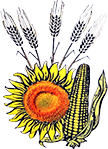Leaf Epicuticular Wax as a Goal if the Wheat Breeding to Improve Resistance to Biotic and Abiotic Stress
Matilda Ciucă1, Daniel Cristina1, Alina-Gabriela Turcu1, Elena-Laura Conțescu1, Alexandru-Leonard Dumitru1, Cristina-Mihaela Marinciu1, Gabriela Șerban1, Vasile Mandea1, Elena-Florența Helepciuc2, Elena Monica Mitoi2, Ana-Maria Moroșanu2, Anca Manole2, Alexandru Brânzan2, Gabriel Maria2
1National Agricultural Research and Development Institute Fundulea
2Institutul de Biologie al Academiei Române București
Keywords: epicuticular wax, wheat, Iw2 locus, electron microscopy, molecular markers.
Abstract: Epicuticular wax on the aerial surface of wheat (leaves, stems, sometimes even spike) has the function of protection against many environmental stresses and thus, resulting higher yields under stress.
In this study, analyses regarding the amount of wax and the type of wax crystals (performed using electron microscopy) on a set of wheat varieties, breeding and pre-breeding lines, showed a great variability of the amount of wax and scanning electron microscopy (SEM) showed a greater variation of the type of wax crystals on the leaf abaxial side between the glaucous/nonglaucous genotypes. Therewith, in 2021 field, the yield differences between two wheat lines (glaucous and non-glaucous) cultivated in ten locations in Romania (Brașov, Caracal, Secuieni, Albota, Telorman, Fundulea, Turda, Oradea, Lovrin and Dobrogea) have highlighted the role of the wax layer in certain environmental conditions, the wax (glaucous) line obtaining higher yield at seven locations, with the highest difference (wax line – non wax line yield) of 1414 kg in Brașov. Nevertheless, in three locations the non-wax (non-glaucous) line had higher yield than the wax line, in Dobrogea the yield difference reached 599 kg.
Molecular analyzes performed at the level of three loci involved in the synthesis of the epicuticular wax or in the wax inhibition showed the significant role of the Iw2 locus, clearly separating the wax and non-wax genotypes from the winter wheat (Triticum aestivum L.) except pre-breeding lines obtained by crossing with wild species related to wheat, such as Aegilops ventricosa and Agropyron junceum. These results lead to the start of studies regarding the composition of the epicuticular wax layer in the adaptation of wheat to unfavorable conditions.
